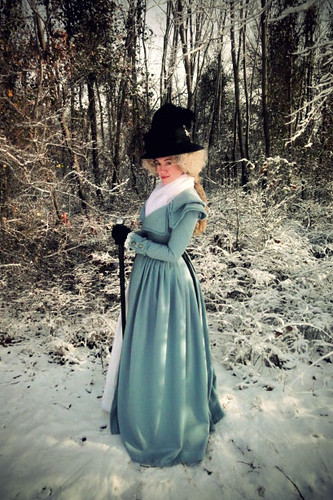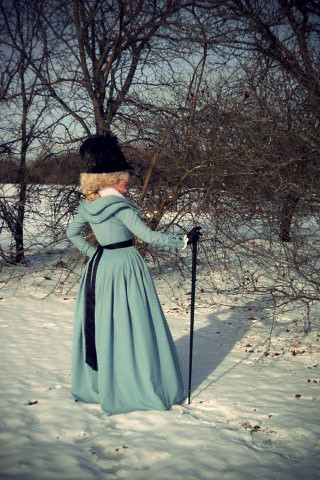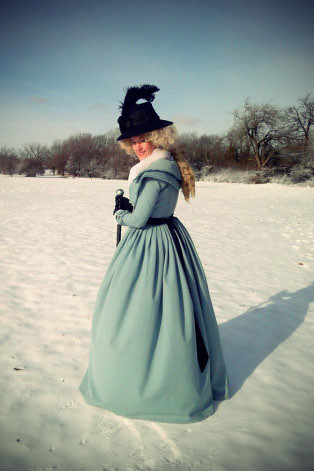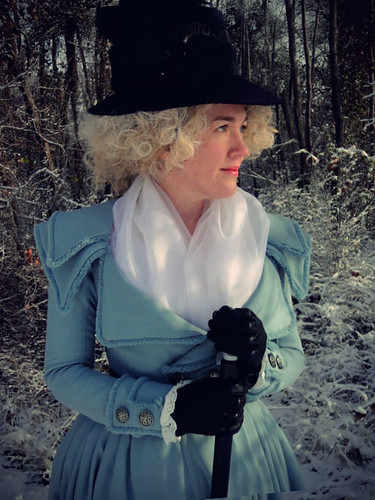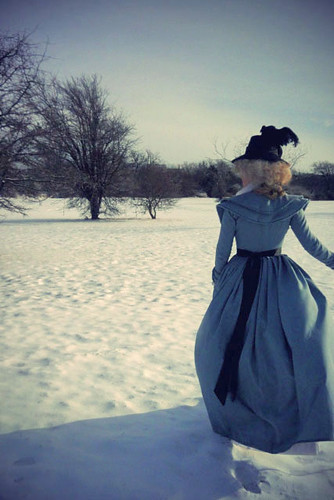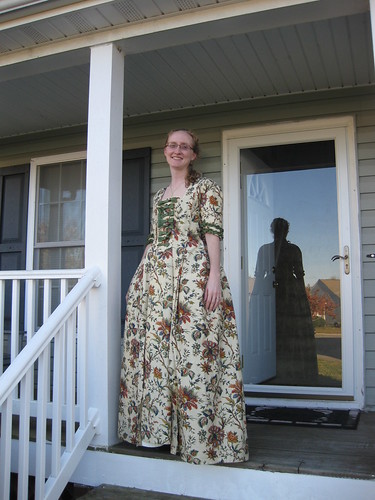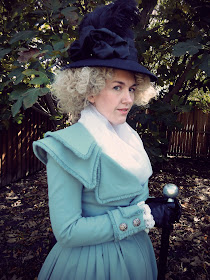I hope you all had a wonderful holiday! This year, we were treated to a very rare white Christmas in Texas, and my whole family had so much fun frolicking in the snow.
Since I didn't get a lot of good posed pictures of my new redingote last month, I decided to make use of the pretty winter backdrop today and snapped a few more pics at the park. It was so much fun wearing this outfit in cold weather. I stayed nice and warm in my gown, and the colors seem to go so perfectly with the snow and bare trees. I could have kept going for hours, but my son decided that more snowball fights were in order, so I changed back into my street clothes and returned to 21st century mom-mode. Unfortunately, my camera doesn't like cold weather and all of my pictures are a bit out of focus and hazy, but we're going to call that blurriness "artsy" and go with that. ;) But anyway, it was a fun little excursion and a perfect Christmas gift from mother nature for a costume nerd like myself.
Wednesday, December 26, 2012
Monday, December 3, 2012
A late 20's dress for Lanternlight
This past Saturday, a group from the DFWCG attended Plano Heritage Farmstead's holiday celebration - Lanternlight. The theme for this event is usually turn-of-the-century Victorian/Edwardian, but this year they switched things up a little and did 1920's, which was SO much fun!
In the past, I've kind of turned up my nose at 20's fashions because I don't find them to be the most flattering styles, but I've really come around over the past few years and I'm enjoying them more and more. I've discovered that not all 20's dresses look like shapeless feedsacks, and some of the styles are really chic and fun to wear.
For my dress, I used an undated Pictorial Review pattern, which I am guessing from the styling is from 1930-32ish. But you can see from the pattern diagram on the back that there is almost no shaping in the dress, and I discovered that if you wear the belt at the hips and shorten the skirt a little, it passes for a 20's dress with no problem. You could really see the changes going on in the pattern industry with the way this pattern was made. It has a very brief instruction sheet like older patterns with only the most basic construction steps covered, but then it also has printing on the pattern pieces with cool little illustrations and extra hints and tricks for how to put it all together. Compared to the other 1910's and 1920's patterns that I own, this wealth of information must have been such a welcome change for home seamstresses! The only changes that I made to the Pictorial pattern was to leave off the cuffs (no good reason why - I just got lazy), and I also omitted the collar so I could wear a fur collar instead.
 Although you see a ton of fur collars on coats in the 20's, it's much harder to find them on dresses. I got really excited when I found this 1927-28 dress illustration in the book Montgomery Ward Fashions of the Twenties (there's a link at the bottom of this post), since it appears to have an attached fur collar and it looks so similar to my dress anyway. But there is nothing noted about it being fur in the text, so I'm guessing it was really some type of velvet or plush. I have occasionally seen photos of women with fur collars worn with a dress, like this one, but I'm pretty sure most of those are stoles instead of anything that is attached. Obviously, it doesn't make sense to put fur on a dress that needs to be washed, but I was really determined to have a fur collar on this outfit, so I did it anyway. Shhh... don't tell the authenticity police! I found this clip-on fox fur collar on etsy, and since it is not permanently attached, I can still wear the dress and wash the dress without the fur, so I don't feel quite as guilty about it.
Although you see a ton of fur collars on coats in the 20's, it's much harder to find them on dresses. I got really excited when I found this 1927-28 dress illustration in the book Montgomery Ward Fashions of the Twenties (there's a link at the bottom of this post), since it appears to have an attached fur collar and it looks so similar to my dress anyway. But there is nothing noted about it being fur in the text, so I'm guessing it was really some type of velvet or plush. I have occasionally seen photos of women with fur collars worn with a dress, like this one, but I'm pretty sure most of those are stoles instead of anything that is attached. Obviously, it doesn't make sense to put fur on a dress that needs to be washed, but I was really determined to have a fur collar on this outfit, so I did it anyway. Shhh... don't tell the authenticity police! I found this clip-on fox fur collar on etsy, and since it is not permanently attached, I can still wear the dress and wash the dress without the fur, so I don't feel quite as guilty about it.
My dress is made from polyester crepe, which is another strike against me on authenticity. But I had my mind set on making it in deep red, and when I was buying fabric for it last summer, this is the only dark red crepe that I could find. The buttons and belt buckle are all vintage mother of pearl.
For the hat, I reshaped a modern wool felt hat using my vintage hat block. I'm kicking myself for not taking pictures of that process now, but I was so tired this past week that it never crossed my mind until I was almost done. But all I did was wet the hat and stretched it and pinned it over the block so it would sit down much farther on my head. Once it was dry, I cut the brim to a shape that I liked, then wired and bound the edge of the brim with a strip of silk taffeta. For the decorations, I had originally planned on making some fancy fabric flowers, but I ran short on time, so I ended up buying a huge velvet poinsettia from Hobby Lobby, and I hot glued the individual petals onto the hat.
The shoes are from Aerosoles, and they are called Ticker Tape. I thought they were so perfect for 20's costumes, and they were quite comfortable too. I just replaced the leather cord with a ribbon since I didn't like the way the cord looked on its own. Aerosoles has quite a few retro-styles of shoes, and they have good sales too if you are patient and keep checking back.
So that's about it. I had a blast wearing this costume, and I was pleasantly surprised at the number of compliments that I received at the event. I guess 20's dresses might not be so terribly unflattering after all. ;) You can see more pictures from the event on my Flickr page.
Thursday, November 29, 2012
Featured Curtain-Along Sacque, by Mary Burbage
This week, we have another amazing Curtian-Along dress made by Mary Burbage. Mary made a 1750’s Indienne print sacque, petticoat, and stomacher, and she sent us this fabulous write-up to tell you more about her work:
For the Festive Attyre Curtain-Along project, I made a 1750’s sacque, petticoat, and stomacher.
Materials:
- three Waverly Felicité curtain panels (from Amazon)
- 4 5/8 yd 1” moss green china silk ribbon (from Silky Way)
- 1 1/8 yd bleached muslin (from JoAnn)
- 2 ½ yd 1” cotton twill tape (from JoAnn)
The bodice lining was a modified version of the Simplicity Pirates of the Caribbean gown (S4092). I adjusted the armscye shape a bit to make it more accurate. I also moved the side seam back further, again to make it more accurate. I omitted the lacing because I didn’t feel like fooling with it this time around. I knew it should fit reasonably well since it had been fine when I made my celadon sacque a few years ago.
The sacque itself was draped on the dummy following the tutorials on The Fashionable Past (http://koshka-the-cat.blogspot.com/2011/03/draping-sort-of-sacque-part-one.html) and patterns in Patterns of Fashion: The Cut and Construction of Englishwomen’s Clothes 1660-1860 by Janet Arnold – the 1745-1755 sack for wide hoops on pp. 32-34 and the 1745-1755 pet-en-l’air on pp. 28-30. The sleeves were taken from the 1770-1775 sacque on pp. 34-35, mostly because I already had that pattern piece printed out from last year’s rust taffeta en fourreau gown.
The petticoat was the same as my rust taffeta petticoat from last year, which used the 18th century petticoat tutorial on Katherine’s Dress Page. This tutorial is similar to the petticoat tutorial on A Fashionable Frolick except that it also covers waist shaping.
The stomacher is just cut to a pleasing shape.
Construction:
The sacque, petticoat, and stomacher are made of indienne print cotton sateen. The bodice, sleeves, and stomacher are lined with muslin. The sleeves are trimmed with two rows of ruched china silk ribbon, and the stomacher is trimmed with eight china silk bows in graduated sizes. All pieces were sewn by hand.
There’s really not much else to say about construction since the tutorials are so detailed.
I’m still not quite sure that trimming the sleeves with ruched ribbon rather than having cuffs was correct for the 1750’s, but I can use the fabric out of the curtain tiebacks if I decide to make cuffs in the future. I’d have to do a lot of piecing if I were going to try to do it with the scraps from the curtain panels.
Because of the method of making the bodice by cutting out the armscye and folding/pleating the rest of it, this really did take practically all of the three lengths of fabric. I was able to make the matching petticoat without piecing in a different fabric at the top, but I did have to do a little piecing to make it work. I did not cut this with a train so that I could dance in it. I saw several online that were trained, which was appealing but not so practical.
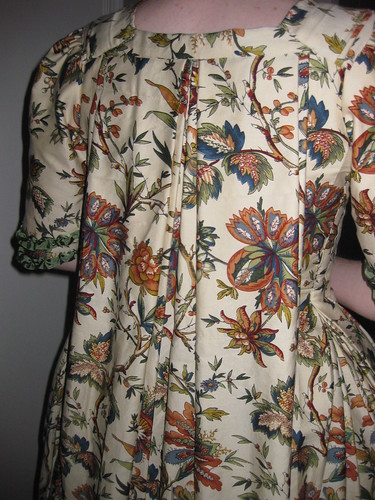
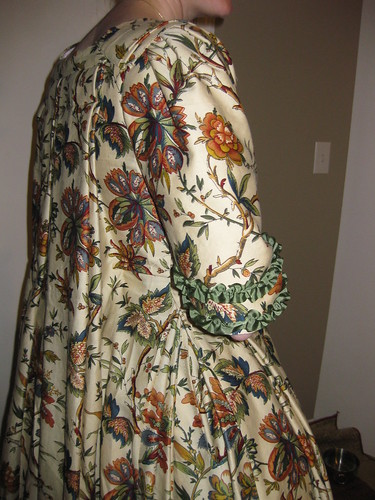
Undergarments:
I wear this gown and petticoat over a chemise (Simplicity 3635), fully boned stays (Simplicity 3635), pocket hoops (Simplicity 4092), and two petticoats based on the same tutorials as the print petticoat.
Thoughts after wearing:
I love this dress. It was great to wear and had great range of motion for the arms. I had absolutely no problems dancing in it, even doing “The Duke of Kent’s Waltz” where the lady keeps turning under the gentleman’s arm.
I am definitely looking forward to wearing it again at Holidays at Smithfield. I doubt anyone will mind the 1750’s gown at the 1770’s plantation!
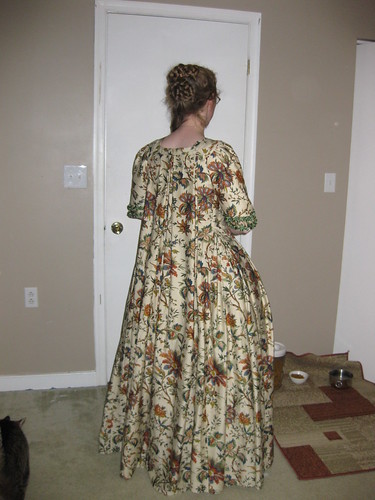
Saturday, November 24, 2012
two new curtain dresses
A few people have asked me how they can share pictures of their curtain-along dresses if they don't have a blog, and the answer to that one is easy - just send it to me and I'll post it for you! It'll be fun to showcase the work of others here on my blog, and it brings back good memories of when I used to do that years ago on the Featured Attyre section of my old website.
So I'm incredibly excited to get the ball rolling with two new curtain-along projects made by some of my local friends in the DFWCG. First up is Chloe Hinton who made a lovely jacket using the caraco pattern in Janet Arnold's Patterns of Fashion. To dress it up a little, she trimmed the edges with box pleated grosgrain ribbon.
And next is Erin C. who sent me this description of her gown:
So I'm incredibly excited to get the ball rolling with two new curtain-along projects made by some of my local friends in the DFWCG. First up is Chloe Hinton who made a lovely jacket using the caraco pattern in Janet Arnold's Patterns of Fashion. To dress it up a little, she trimmed the edges with box pleated grosgrain ribbon.
And next is Erin C. who sent me this description of her gown:
The dress was made using Sense & Sensibility's Portrait Dress pattern. I'd never made one of their patterns before, and was pleasantly surprised that I didn't have to make any adjustments aside from sleeve width and cutting the neckline slightly lower. The mustard petticoat is a linen I bought at Joann's. Shoes by American Duchess (of course). The hat I decorated from a plain straw one from Jas. Townsend.
If you have any questions or feedback for either of these lovely ladies, just leave it in the comments and I'll make sure they get the message. And if anybody else has completed curtain-along projects that you would like to share, email me at jen(at)festiveattyre.com
Friday, November 23, 2012
the 1790 Redingote
So my original plan for the Georgian Picnic was to make my curtain-along jacket, but as you can see, that didn't happen. I am a hopeless sheep when it comes to costumes, so when my wonderful friend from Before the Automobile decided that she was going to make a redingote for our event, I decided that I HAD to have one too! I've been wanting a redingote for years and years, but I've always been intimidated by the tailoring involved. Luckily several of my online friends who have made redingotes in the past helped me out and shared patterns, construction tips, and fabric sources to get me started. I am SO grateful for their help!

But instead of doing an exact copy of this first dress, I decided to combine it with elements of this second portrait that is undated, but has many similar elements in the overall style. I loved the fringe, figured buttons, and the shape of the cuffs, so this gave me ways to dress up my redingote a little and make it more unique.
My dress is constructed from wool twill and lined with heavy linen, and it is 100% hand-sewn. Because the color would have been impossible to match exactly, I made my own fringe from strips of the wool that I unraveled. It is really easy to make your own fringe, and it actually goes faster than you would think. My buttons are the large feather style pewter buttons from Quartermaster General. They were shiny silver when I got them, but I added some black enamel paint in the recesses to make the design stand out better. My neckerchief is made from silk organza, the petticoat is cotton voile, and my sash is satin. The hat is a cheap straw gardening hat that I found at an estate sale. I covered it with wool and decorated it with a vintage moire ribbon and a few feathers in a manner somewhat similar to the all-black hat shown at the bottom of this fashion plate.
I didn't take construction photos because I'm still a total novice when it comes to proper 18th c. dressmaking techniques, so I don't want to lead anybody astray or draw attention to all of my mistakes. But I will tell you that I the lower lapels are interlined with heavy linen, and the capes are interlined with medium weight hair canvas. Although the lapels worked just fine without the hair canvas, I wish I had interlined the front of the bodice with hair canvas. Because the bodice is so extremely low cut there isn't much there to support the weight of the lapels, so it tends to droop a little and make wrinkles on the lower bodice. I might try to retro-fit the bodice with some more interlining to see if that helps a little, but that was my only major complaint about the way it fits. The capes were crazy looking at first because they were so stiff and perky, but after lots and lots of steaming and shaping over a tailor's ham, they decided to cooperate and lay nicely. I will also need to go back and re-hem my skirt at some point. It's about an inch longer than it should be in the front, and the method that I used for the hem was a complete disaster. I used the le point a rabattre sous la main stitch described in Costume Close Up, but the way the thread wraps around the edge of the hem makes it snag easily on just about anything, and my skirt was a puckered mess before the end of the picnic. Oh well, lesson learned.
One of the scariest parts about this project for me was figuring out the pattern for the bodice, so I thought I'd show you what my pattern pieces looked like. Sometimes it's just nice to know what shapes you should be shooting for. My pattern was made from a combination of draping and looking at the redingote pattern diagram from the book Die Kostümsammlung der Familie von Bassermann-Jordan als Beispiel für die zeitgenössische bürgerliche Mode von 1760-1870 by Heidede Biegler-Sander. Although the huge lapels and capes look really fancy when they are done, they were very straight-forward to pattern. I had to do a bit of alterations in the final fitting, but this still pretty close to what I used for my dress.
So that's about it. I didn't get a lot of formal pictures of my dress last weekend, but maybe I'll get a chance to do some more this winter. Thanks again to Cynthia and Christopher for letting me borrow a few of theirs, and once again, you can find more candid pics in my flickr.
 |
| BTW, this is my "OMG I'm at the GEORGIAN PICNIC" happy face! :) |
Wednesday, November 21, 2012
4th Annual Georgian Picnic
This past Saturday, the DFWCG hosted my favorite event of the year - our Georgian Picnic. I'm having a hard time putting into words exactly how amazing this event was, so I'm just going to let some of my favorite the pictures do most of the talking.
Hope to see you at next year's Georgian Picnic!
Okay, I could keep going and going, but I'll just point you to my flickr album if you'd like to see more. Many thanks to Christopher, Cynthia, and Maggie for letting me use several of their pics. I'll be back to talk more about my new dress later this week.
Hope to see you at next year's Georgian Picnic!


